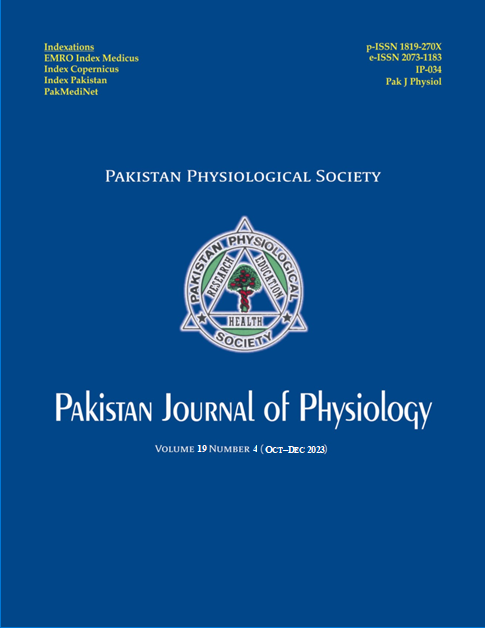INCIDENCE OF OCULAR TRAUMA AMONG THE PATIENTS HOSPITALIZED IN THE OPHTHALMOLOGY DEPARTMENT OF AYUB TEACHING HOSPITAL
DOI:
https://doi.org/10.69656/pjp.v19i4.1553Keywords:
Ocular Trauma, Ocular Injury, Corneal Laceration, Intraocular foreign body, Eyelids lacerationAbstract
Background: Ocular trauma is leading cause of mono or binocular vision deterioration. This study was conducted to determine the incidence of ocular trauma in patients in our set-up. Methods: A retrospective observational study was done from Nov 2021 to Jan 2022 on all admitted patients for age, gender, occupation and activity at the time of injury, nature of injury, and traumatic agent. Data were classified into 5 groups on basis of trauma setting. Injuries were grouped in accordance with Birmingham Eye Trauma Terminology System. Results: The total number of patients admitted to the Ophthalmology Department was 458. Out of these, 61 (13.31%) patients were admitted with Ocular trauma. Ocular trauma was highest in age group of 1–20 years (59%), followed by age group 21–40 years (31.1%). Ocular trauma was very frequent (39.34%) in 1st decade of life. Males were most affected (80.3%). The most common setting for ocular injuries was sports/playtime (44.26%) followed by work-related injuries (27.86%) and household/indoor injuries (16.39%). Blunt objects accounted for most trauma (50.81%) followed by sharp objects (45.9%). Wood (39.34%) was the most common traumatic agent followed by stone (24.59%). Cornea (43.47%) was the most frequently damaged tissue followed by eyelids (41.30%). Conclusion: Ocular trauma was highest during sports/playtime, especially in the first decade of life. There is a need for parents’ education regarding the risk of ocular trauma with trivial objects such as toys and utensils and the impact of ocular trauma on vision.
Pak J Physiol 2023;19(4):29–31
Downloads
References
Jackson H. Bilateral blindness due to trauma in Cambodia. Eye (Lond) 1996;10 (Pt 4): 517–20.
Mallika P, Tan A, Asok T, Faisal H, Aziz S, Intan G. Pattern of ocular trauma in Kuching, Malaysia. Malays Fam Physician 2008;3(3):140–5.
Thylefors BI. The WHO Programme for the Prevention of Blindness. Ophthalmic Epidemiol 1994;1(1):3–4.
Négrel AD, Thylefors B. The global impact of eye injuries. Ophthalmic Epidemiol 1998;5(3):143–69.
Hutton WL, Fuller DG. Factors influencing final visual results in severely injured eyes. Am J Ophthalmol 1984;97(6):715–22.
Malik IQ, Ali Z, Rehman A, Moin M, Hussain M. Epidemiology of penetrating ocular trauma. Pak J Ophthal 2012;28(1):14–6.
Iqbal Y, Khan QA, Zia S, Malij A. Frequency and characteristics of ocular trauma in Gilgit, Pakistan. J Islam Int Med Coll 2016;11(4):157–62.
Cillino S, Casuccio A, Di Pace F, Pillitteri F, Cillino G. A five-year retrospective study of the epidemiological characteristics and visual outcomes of patients hospitalized for ocular trauma in a Mediterranean area. BMC Ophthalmol 2008;8:6.
El-Sobky HM, Ellakwa AF, El-Sawy MF, Hamed AA. Incidence and pattern of ocular trauma among ophthalmic patients in Menoufia University Hospitals. Menoufia Med J 2019;32(4):1430–5.
Iqbal U, Malik IQ, Iqbal H. Epidemiology of ocular trauma in a tertiary hospital setting. Pak J Ophthalmol 2019;35(1):47–54.
Babar TF, Khan MT, Marwat MZ, Shah SA, Murad Y, Khan MD. Patterns of ocular trauma. J Coll Physicians Surg Pak 2007;17(3):148–53.
Jahangir T, Butt NH, Hamza U, Tayyab H, Jahangir S. Pattern of Presentation and factors leading to ocular trauma. Pak J Ophthalmol 2011;27(2):96–102.
Choovuthayakorn J, Worakriangkrai V, Patikulsila D, Watanachai N, Kunavisarut P, Chaikitmongkol V, et al. Epidemiology of eye injuries resulting in hospitalization, a referral hospital-based study. Clin Ophthalmol 2020;14:1–6.
Bahoo MLA Jamil AZ, Karamat B. Frequency and characteristics of ocular trauma in a tertiary care hospital in Lodhran. Pak J Ophthalmol 2019;34(2):116–21.
Qayum S, Anjum R, Rather S. Epidemiological profile of pediatric ocular trauma in a tertiary hospital of northern India. Chin J Traumatol 2018;21(2):100–3.
Zungu T, Mdala S, Manda C, Twabi HS, Kayange P. Characteristics and visual outcome of ocular trauma patients at Queen Elizabeth Central Hospital in Malawi. PLOS One 2021;16(3):e0246155.
Thompson CG, Kumar N, Billson FA, Martin F. The aetiology of perforating ocular injuries in children. Br J Ophthalmol 2002;86:920–2.
Shaeri M, Moravveji A, Fazel MR, Rangraz Jeddi F. Status of ocular trauma in hospitalized patients in Kashan, 2011: As a sample of industrial city. Chin J Traumatol 2016;19(6):326–9.
Megbelayin EO, Nkanga DG, Ibanga A, Okonkwo SN. Pattern and causes of ocular injuries in Calabar, Cross River State, Nigeria. J Trauma Care 2016;2(1):1012.
Downloads
Published
How to Cite
Issue
Section
License

This work is licensed under a Creative Commons Attribution-NoDerivatives 4.0 International License.
The author(s) retain the copyrights and allow their publication in Pakistan Journal of Physiology, Pak J Physiol, PJP to be FREE for research and academic purposes. It can be downloaded and stored, printed, presented, projected, cited and quoted with full reference of, and acknowledgement to the author(s) and the PJP. The contents are published with an international CC-BY-ND-4.0 License.











